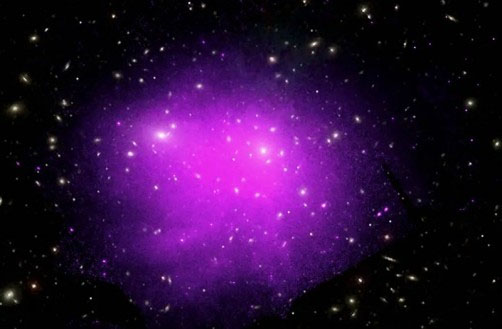| Feb 08, 2024 |
Testing the evolution of the Universe with galaxy clusters
|
|
(Nanowerk News) 100 billion – there are at least that many stars in our Milky Way. It seems like an unimaginable number. Yet astrophysicists study structures in our universe that are far bigger than galaxies alone. These clusters of galaxies look tiny in the images telescopes give us, yet represent a massive number of cosmic objects.
|
|
How matter is distributed throughout these galaxy clusters helps us investigate the very nature of the structure of the universe and how it evolved. Scientists from the Department of Energy’s SLAC National Accelerator Laboratory and Stanford University combined observational and simulated data to ensure that how researchers measure this distribution of matter is accurate.
|
 |
| This image represents a deep dataset of the Coma galaxy cluster obtained by NASA’s Chandra X-ray Observatory. (Image: NASA)
|
|
The leading theory of the universe’s structure and evolution is called Lambda-CDM (cold dark matter). As observational data has revealed, most of the universe is made up of a mysterious substance called dark matter. Scientists haven’t been able to capture or observe a dark matter particle. However, we know it’s there because of how its gravity affects cosmic objects like galaxy clusters.
|
|
Lambda-CDM as an explanation predicts how mass – including dark matter – is distributed in certain cosmic structures. In particular, it describes the relationship between the mass of a galaxy cluster and how that mass is distributed within it. If scientists can calculate that relationship with observational data, they can test how well the theory holds up.
|
|
But measuring the density and distribution of matter in a galaxy cluster isn’t simple. Unlike a reasonably-sized object, scientists can’t just put galaxy clusters on a scale. There are two major ways to make this measurement. However, both ways have drawbacks. One way – called gravitational lensing – can be very accurate but is affected by the mass of all of the objects between us and the galaxy cluster.
|
|
The other method is to take X-ray measurements of the superheated plasma within a galaxy cluster. However, this method only takes accurate measurements of galaxy clusters that are relaxed. In this case, relaxed doesn’t mean the opposite of stressed. It means there’s a balance between gravity and the energy from the gas in the cluster. Relaxed galaxy clusters are in equilibrium.
|
|
The problem is that not all galaxy clusters are relaxed. Scientists wanted to know if the conclusions they were drawing from these particular clusters represented galaxy clusters as a whole.
|
|
To solve this problem, scientists from SLAC and Stanford developed a way to test the assumption using simulated data. A previous study ("ARTIKEL") had developed a set of 324 high-resolution simulations of galaxy clusters. The software didn’t base the simulations on physics theory about how individual particles work. Those simulations would have just given the results the theories predicted. Instead, the software created simulated images very much like the images we take with telescopes. These images allow scientists to analyze the simulations the same way they would observational data.
|
|
First, the SLAC and Stanford scientists calculated what the X-ray emissions for each of the simulated clusters should be. They then narrowed the data set down to ones that would have been “relaxed” in real life. This step allowed them to compare apples to apples. Next, they compared this set with data from 44 real-life galaxy clusters gathered by NASA’s Chandra X-ray Observatory. For each cluster, simulated and real, they calculated the mass of the cluster, how concentrated the mass is in the center of the cluster, and a measurement that reflects how old the universe was when the cluster emitted the light. (It takes millions of years for light from these clusters to reach Earth.) They then could figure out the relationship between those three properties.
|
|
The astrophysicists found that the relationships in the simulated and observational data matched each other very well. Within both, they found that the mass in the clusters gathers more towards the center over time. At any given time, clusters with less mass overall have more of that mass concentrated in the center than clusters with more mass. This relationship matches what Lambda-CDM predicts, which gives further support for the theory.
|
|
Future projects will provide even more observational data for scientists to work with (Monthly Notices of the Royal Astronomical Society, "The Concentration–Mass relation of massive, dynamically relaxed galaxy clusters: agreement between observations and ΛCDM simulations"). The Legacy Survey of Space and Time (LSST) at the Vera Rubin Observatory and the Cosmic Microwave Background-S4 study will gather more images and data on galaxy clusters. Upcoming space missions will take complementary X-ray measurements.
|
|
Explaining how the universe – literally everything that exists – evolved is certainly complex. But research into some of the biggest structures in the universe is helping us understand it better.
|

